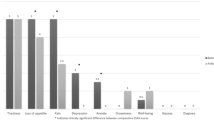Abstract
Background
Malignant ascites (MA) is a distressing problem usually managed by repeated paracenteses. Paracentesis represents a meaningful time point in identifying patients with a specific presentation.
Objective
The objective of this study is to examine symptom clustering in MA patients at paracentesis.
Methods
Pre- and post-paracentesis, patients completed the Edmonton Symptom Assessment Scale revised to include abdominal distension and mobility (ESAS:AM) and the European Organization for Research and Treatment of Cancer Quality of Life Questionnaire (EORTC QLQ-C30). This is a secondary analysis of data previously published, which reported on the validity of these surveys in MA. The symptoms were clustered using a hierarchical cluster analysis technique.
Results
In 37 cancer patients with complete data, there were two clusters common at both pre- and post-paracentesis time points: (1) depression–anxiety; (2) fatigue–appetite–wellbeing–mobility. Paracentesis resulted in an improvement in ESAS/AM total score (SDS/AM), abdominal distension, and shortness of breath (P < 0.001, threshold adjusted for multiple comparisons). On the EORTC QLQ-C30, the domains of role functioning and global quality of life (QOL) showed a trend towards improvement, while the domains of cognitive and emotional QOL declined significantly (P < 0.001, threshold adjusted for multiple comparisons), despite improvement in individual symptoms commonly attributed to ascites.
Conclusions
This study is the first to describe symptom clusters in MA. Studies in MA should include measurement of the more global symptoms of fatigue, wellbeing, depression, and anxiety in addition to shortness of breath, abdominal distension, and mobility. Patients presenting with MA require a comprehensive assessment and a management plan that addresses QOL and the emotional domain symptoms shown to cluster in these patients.




Similar content being viewed by others
References
Kim HJ, McGuire DB, Tulman L, Barsevick AM. Symptom clusters: concept analysis and clinical implications for cancer nursing. Cancer Nurs. 2005;28(4):270–82.
Woods NF, Mitchell ES, Lentz M. Premenstrual symptoms: delineating symptom clusters. J Womens Health Gend Based Med. 1999;8(8):1053–62.
Lacasse C, Beck SL. Clinical assessment of symptom clusters. Semin Oncol Nurs. 2007;23(2):106–12.
Dodd MJ, Miaskowski C, Paul SM. Symptom clusters and their effect on the functional status of patients with cancer. Oncol Nurs Forum. 2001;28(3):465–70.
Barsevick AM, Whitmer K, Nail LM, Beck SL, Dudley WN. Symptom cluster research: conceptual, design, measurement, and analysis issues. J Pain Symptom Manage. 2006;31(1):85–95.
Parsons SL, Lang MW, Steele RJ. Malignant ascites: a 2-year review from a teaching hospital. Eur J Surg Oncol. 1996;22(3):237–9.
Mackey JR, Venner PM. Malignant ascites: demographics, therapeutic efficacy and predictors of survival. Can J Oncol. 1996;6(2):474–80.
Easson AM, Bezjak A, Ross S, Wright JG. The ability of existing questionnaires to measure symptom change after paracentesis for symptomatic ascites. Ann Surg Oncol. 2007;14(8):2348–57.
Geisser M, Perna R, Kirsch N, Bachman J. Classification of chronic pain patients with the brief symptom inventory: patient characteristics of cluster profiles. Rehabil Psychol. 1998;43:313–26.
Walsh D, Rybicki L. Symptom clustering in advanced cancer. Support Care Cancer. 2006;14(8):831–6.
Cleeland CS, Mendoza TR, Wang XS et al. Assessing symptom distress in cancer patients: the M.D. Anderson Symptom Inventory. Cancer. 20001;89(7):1634–46.
Johnson R, Wichern D. Applied multivariate statistical analysis. Prentice-Hall: Upper Saddle River; 1982.
Kupier F, Fisher L. Monte Carlo comparison of six clustering procedures. Biometrics. 1975;31:777–83.
Chang VT, Hwang SS, Feuerman M. Validation of the Edmonton Symptom Assessment Scale. Cancer. 2000;88(9):2164–71.
Philip J, Smith WB, Craft P, Lickiss N. Concurrent validity of the modified Edmonton Symptom Assessment System with the Rotterdam Symptom Checklist and the Brief Pain Inventory. Support Care Cancer. 1998;6(6):539–41.
Edmonton Palliative Care Program. Edmonton Symptom Assessment System. 2002. http://www.palliative.org/PC/ClinicalInfo/AssessmentTools/esas.pdf.
Aaronson NK, Ahmedzai S, Bergman B, et al. The European Organization for Research and Treatment of Cancer QLQ-C30: a quality-of-life instrument for use in international clinical trials in oncology. J Natl Cancer Inst. 1993;85(5):365–76.
Bjordal K, de GA, Fayers PM, et al. A 12 country field study of the EORTC QLQ-C30 (version 3.0) and the head and neck cancer specific module (EORTC QLQ-H&N35) in head and neck patients. EORTC Quality of Life Group. Eur J Cancer. 2000;36(14):1796–807.
Osoba D, Zee B, Pater J, Warr D, Kaizer L, Latreille J. Psychometric properties and responsiveness of the EORTC quality of Life Questionnaire (QLQ-C30) in patients with breast, ovarian and lung cancer. Qual Life Res. 1994;3(5):353–64.
Teunissen SC, de GA, Voest EE, de Haes JC. Are anxiety and depressed mood related to physical symptom burden? A study in hospitalized advanced cancer patients. Palliat Med. 2007;21(4):341–6.
Vignaroli E, Pace EA, Willey J, Palmer JL, Zhang T, Bruera E. The Edmonton Symptom Assessment System as a screening tool for depression and anxiety. J Palliat Med. 2006;9(2):296–303.
Miaskowski C, Cooper BA, Paul SM, et al. Subgroups of patients with cancer with different symptom experiences and quality-of-life outcomes: a cluster analysis. Oncol Nurs Forum. 2006;33(5):E79–89.
Dodd MJ, Miaskowski C, Lee KA. Occurrence of symptom clusters. J Natl Cancer Inst Monogr. 2004;32:76–8.
Gift AG, Jablonski A, Stommel M, Given CW. Symptom clusters in elderly patients with lung cancer. Oncol Nurs Forum. 2004;31(2):202–12.
Kurtz ME, Kurtz JC, Given CW, Given B. Loss of physical functioning among patients with cancer: a longitudinal view. Cancer Pract. 1993;1(4):275–81.
Chen ML, Tseng HC. Symptom clusters in cancer patients. Support Care Cancer. 2006;14(8):825–30.
Becker G, Galandi D, Blum HE. Malignant ascites: systematic review and guideline for treatment. Eur J Cancer. 2006;42(5):589–97.
Acknowledgment
We are grateful for the contribution of Dr. Alice Newman, Fariba Sam, Barbara Thomson, Jennifer Jones, Jacqueline Leung, Erica Moran, and Christopher Obwanga. The study was supported by a grant from Physician Services Incorporated Fund, the Rose and Arthur Brooks Memorial Fund, and the Frankfort Fund.
Author information
Authors and Affiliations
Corresponding author
Rights and permissions
About this article
Cite this article
Husain, A., Bezjak, A. & Easson, A. Malignant Ascites Symptom Cluster in Patients Referred for Paracentesis. Ann Surg Oncol 17, 461–469 (2010). https://doi.org/10.1245/s10434-009-0774-0
Received:
Published:
Issue Date:
DOI: https://doi.org/10.1245/s10434-009-0774-0




